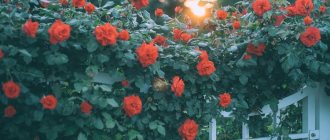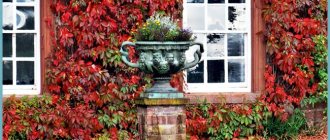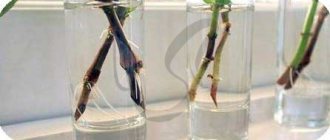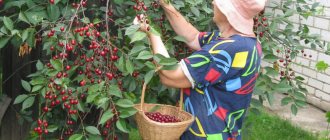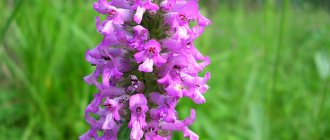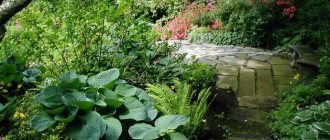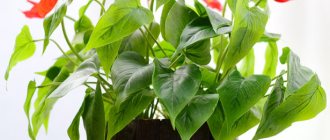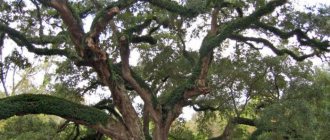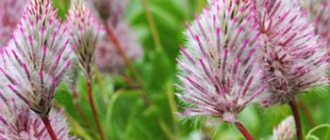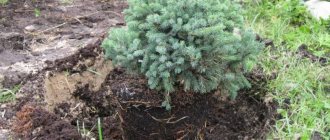We all know from school that plants require sufficient sunlight for normal growth and development. Without delving particularly deeply into the jungle of biology, we often mistakenly believe that trees, shrubs, vegetable and ornamental crops cannot grow, bloom, or bear fruit in the shade. Therefore, we simply impoverish both ourselves and the appearance of our estate by not planting anything in the shade of the house or fence. In the meantime, in any region, even with the harshest climate and short summers, you can select shade-loving and shade-tolerant plants that will decorate the facade of the house and the line of the continuous fence.
Most shade-loving plants are consistently decorative throughout the warm season. However, they are not distinguished by abundant or very lush flowering. All their beauty lies in the unusual color of the foliage and the shape of the bushes.
The shaded areas of a dacha or country house are very different from each other. Some of them are illuminated by the sun for only a few hours a day, while some receive only passing rays. And there are also those where the sun never looks at all. What to plant along the fence if your favorite plants simply don’t want to grow in the shade?
Shade-tolerant and shade-loving trees
Only a small number of trees can be planted between the house and the fence, that is, where there is least sunlight. It is difficult to grow and develop well in such conditions. However, there are tree species that will brighten up a shaded corner on your property. A little patience in studying this issue and you will know which trees to plant along the fence to improve the appearance of the entire estate.
Although most conifers prefer sunny, open places, among them there are specimens for planting in front of a house or fence, where little sun gets. The following shade-tolerant conifers are most often planted on the street side:
- Pointed yew "Nana". This compact tree will thrive in areas that receive only a short amount of sun. Its small dimensions (height - up to 90 cm, crown diameter - from 0 to 90 cm) allow this variety of yew to be planted in front of the house on the street side, as well as between the house and the fence. Yew Nana grows slowly, prefers moist, loose soil. It’s great if the snow cover in the region in winter is very high.
Pointed yew "Nana"
- Siberian fir. The shade-tolerant plant thrives in the northern regions of our country, where it is widely used by landscape design specialists. Until the age of ten it grows slowly. The decorative value of this fir variety is especially evident in the spring, when young cones have a purple tint, and the male oval inflorescences are brownish-red or yellow with a red tinge. Siberian fir can grow well in sunny places. Therefore, it can be used to decorate a corner where the sun gives way to shadow during the day.
Siberian fir
- Viburnum common. This woody flowering plant does well in the shade. Low-growing trees reach a height of no more than 90 cm. Viburnum can be planted as a hedge in front of the house on the street side, replacing the usual fence.
Viburnum common variety "Roseum"
- Rowan. The trees, decorated with clusters of bright umbrellas with berries, are unpretentious to their growing conditions. With their help, they create beautiful contrasting compositions. Rowan can be safely planted in a corner where other plants do not take root well.
What else can be planted along the fence in the shade?
In fact, along the fence in the shade, you can plant absolutely any plants that do well in shaded areas, for example, many decorative coniferous varieties. Also in the forest, where the sun barely penetrates, you can find beautiful flowers. So why not take these notes into account. The main thing is to plant with pleasure. Fortunately, today we are not deprived of information about the proper care of this or that type of plant. Consider your own experience and the advice of other gardeners. Try, experiment, combine colors and shapes.
When planting flowers along the fence, keep the rows - tall ones in the background, and low-growing ones in the front.
Please note that there is an article on the website: “What to plant along the fence at the dacha to close yourself off from the neighbors.”
What shrubs to plant in the shade
Landscaping the shady side of a personal plot can be done with the help of fruit and flowering shrubs. It is better to use species that are accustomed to the local climate for this purpose. The most popular shrub plants that grow well in shaded areas:
- Hydrangea paniculata DVP Pinky. Flowering bushes can be planted in a corner where the sun's rays penetrate only in the afternoon. Flowers in the form of fluffy panicles grow very high. At the beginning of flowering, the panicles are white, and as they mature, they gradually turn pink from the base until they completely become bright pink. Single bushes will look great near the house. They can also be used to form a luxurious hedge.
Hydrangea paniculata DVP Pinky
- Black and red elderberries have excellent decorative properties. They are unpretentious in care, practically do not get sick and tolerate not only the lack of bright light, but also harsh climatic conditions.
Red elderberry
- Red and black currants. In the southern regions, these fruiting bushes will feel good only in the shade. Currants love moisture, so in strong sun they can simply die. In the middle zone, these shrubs are also best planted in shaded areas, but it is worth considering that the fruits will ripen later.
Red currant berries
- Raspberries in a dark patch of garden will produce many large and fragrant berries. It can be placed between the house and the fence. And the place will not remain empty, and will be used practically.
- Irga in nature grows under the forest canopy, so this shrub will feel great in the shady area of the garden. And a seemingly useless place in the garden will turn into a productive berry conveyor belt.
Shrubs in the shade as decorative garden elements
It is recommended to plant shade-loving fruit trees and shrubs for the garden in the shade. By the way, some of them, surprisingly, cannot stand the sun at all and can get burned from its rays.
Shade-loving fruit trees and shrubs for the garden will enliven shaded places with their foliage, and often attention is attracted not by their flowers, but by their leaves: original, varied, adding decorativeness to the overall appearance. Factors such as the varied shape of leaves (kidney-shaped, lobed, heart-shaped, lanceolate), their unusual texture (color shades, raised veins, pubescence) and even arrangement on the stem (alternately, not covering or shading each other) can create an attractive composition, from which you will subsequently be able to obtain an excellent, high-quality harvest.
Vegetables
The space in front of the house is often not used in any way due to the fact that the sun does not reach there most of the day. However, there are a number of vegetable crops that are worth growing in the front garden or near the fence on the street side. Help to implement the project:
- Perennial onion varieties. A very practical option, because in addition to lush greenery, it has decorative properties. For example, chives have huge lilac caps that attract bees.
- Beet. Tolerates shade quite well. The root vegetables will be small but sweet. But not everyone likes coarse, large beets.
- Rhubarb. If you water it regularly, there will always be luxurious bushes of this plant along the fence.
- Cheremsha. In early spring, people rush into the forest to collect young and very healthy wild garlic. If it grows well under trees, then it is quite possible to grow it on your site, where light-loving plants do not want to grow.
- Borago. Borage grows best where there is little direct sunlight. It does not require special care, it is not afraid of spring frosts, and is practically not susceptible to diseases and insect attacks. By planting it in front of your house, you can provide yourself with the necessary vitamins.
Borage borage
- Greens and herbs. Any greens you like will produce well in the shade. It is important to provide it with moisture and reserves can be made even for the winter.
- Horseradish. Spicy foliage is actively used by housewives for winter preparations. And it grows equally well both in the sun and in shady areas.
Trees
Before planting a tree along a fence in the shade or in the sun, you should consider 2 subtleties.
Calculate the percentage of shaded area that forms around the tree and fence. Please note that only plants and trees that tolerate shade can be planted here.
Make room for planting a tree at a distance of 3 m from the fence so that they grow normally. This way you will not risk the fence, which could be damaged by the root system of the plant or the crown of the tree.
In order for trees to grow for their benefit, apple trees, cherries, and peaches are often planted near the fence in the country. Also favorite tree species are rowan and birch, which create a favorable environment. Chestnuts are planted less often near the fence, as the plant grows with a large root system. As for birch and rowan trees, unlike chestnut, they are unpretentious in compatibility with other trees.
To decorate and decorate a private area, to protect it from prying eyes, coniferous plants, linden trees, and willows are planted.
Perennials for the shade garden
It is among perennial plants that most of all are those that prefer areas protected from sunlight. Thanks to this diversity, you can create flower beds, flower beds, mixborders and place them in the shade, either from the street or from the courtyard. Experienced gardeners especially love these plants:
- Hosta grows best away from the sun. And with good soil moisture, its foliage will be simply magnificent, which, depending on the variety, can be monochromatic or variegated. The choice is great. Hostas combine well with other perennials and annuals.
Hosta in the flowerbed
- Lily of the valley is a classic plant for shaded areas of the garden. Flowers in the form of bells will especially delight you in early spring, when they are especially decorative.
Silver lily of the valley
- Astilbe japonica "Bonn" prefers moist soils. Flowers of bright carmine color are shaped like curls. Astilbe needs shade in the afternoon.
Astilbe japonica variety "bonn"
- Meadowsweet will fill the most seemingly lifeless areas with the aromas of summer. Flowers of the “Nana” variety delight the eye with a deep pink hue. Meadowsweet prefers moist, well-drained soil.
Meadowsweet
- Brunnera tolerates any degree of shade very well. It is worth considering that it grows very quickly. Therefore, it is better to plant it in places that require urgent and abundant landscaping.
Brunera sibirica
- Ferns. You simply cannot do without this plant in a shady garden. It goes well with other types of plants. Prefers moist soil.
Choosing shade-tolerant plants for the garden
Shady corners of the garden are a favorite place to relax in the hot summer, so the desire to decorate them is natural. And someone wants to arrange a beautiful flower garden under the trees growing on the site, or plant plants in the shade of a fence or buildings. Shade-tolerant and shade-loving representatives of the flora are suitable for this.
Features of choosing plants depending on the shading of the area
Requirement for light is one of the criteria by which plants are selected for planting in a shaded area. Flowers and shrubs that are in dire need of the sun will not be able to gain strength there or will die completely.
Other plants may be:
- Shade-tolerant , that is, preferring partial shade.
- Shade-loving , grows well with minimal lighting.
This must be taken into account when planning plantings. Typically, decorative deciduous species love shade, although there are many beautiful flowering exceptions. When selecting plants, it is important to pay attention to soil preferences and moisture content.
Popular shade-tolerant groundcovers
Spreading along the ground like a green carpet, ground cover plants will become excellent neighbors to the taller inhabitants of the garden, help decorate the soil around trees and shrubs, decorate the slopes of an alpine hill and fit into a rockery composition. Moreover, many of them cope well with a lack of sunlight.
Creeping tenacious
A plant often found in forests, which became a garden plant thanks to the light hand of flower growers. This is a perennial with shoots spreading along the ground. It blooms early - back in May.
The tenacious inflorescences are spike-shaped: small blue or light blue flowers are collected in axillary whorls. Such “candles” rise 7–12 cm above the ground.
Many decorative varieties have been bred with fancy colored leaves, making the tenacious plant look original and noticeable, despite its small height.
Creeping tenacious
Saxifrage
This is a perennial plant, less often it is bi- or annual. When planted alone, it forms green cushions, usually from 5 to 20 cm in height, in rare cases reaching 70 cm.
Flowers with 5 petals, painted pink or white, rise from the lush greenery on thin stalks.
The main advantages of saxifrage are its unpretentiousness (the plant is frost-resistant and grows without problems on poor soils) and long flowering that lasts all summer.
European hoofweed
Another option for decorating the soil in a shady corner of the garden is hoof grass, which grows up to 30 cm in height. It has cute leaves, the upper side of which is glossy and the lower side is matte. Blooms in spring, with warm weather, with dark burgundy bells.
European hoofweed
Cuff
Cuff attracts attention primarily with its airy flowers, filling the garden with a honey aroma in June and July. The multi-lobed leaves of the plant in many species have a silvery drooping on the underside of the leaf. In the middle zone it overwinters well, but for better preservation, it is still recommended to mulch the bushes with peat.
Also read: Types and methods of watering vegetable and garden crops
Sphagnum moss
In the wild it is an inhabitant of swamps, but due to its high decorative value it is also used in garden compositions . Traditionally white and gray in color, but there are red, pink and ginger specimens. The height of the stems ranges from 10 to 20 cm, from which branched shoots extend in bunches.
All these plants do an excellent job with the main task: decorating the surface of the soil with pretty greenery. Despite their small height, they definitely will not go unnoticed.
Sphagnum moss
If there is not enough sunlight in some corner of the site, this does not mean that there is no place for beautiful flowers. At least 5 plants are ready to fill the shade with their colors.
Dicentra
People often call it “broken heart” because of the characteristic and very unusual shape of the flowers. They are literally suspended in the air on long peduncles. The voluminous dicentra bush grows quite large in size: up to 1 m in height.
Doronicum eastern
The plant has bright yellow flowers, similar to daisies. Doronicum begins its flowering, which lasts more than a month, at the height of May. There are double and dwarf varieties.
Doronicum eastern
Clematis
A very beautiful flowering vine, undemanding to lighting. In floriculture it is used for vertical decoration. The main wealth of clematis is its large flowers of all kinds of colors : from white to dark purple.
Colchicum
Or, as it is called, colchicum. This is a bulbous plant about 20 cm in height that blooms in autumn. You need to be careful when handling colchicum because it is poisonous.
Lily of the valley
The modest and well-known lily of the valley readily grows in the shade. Its snow-white bells usually appear in May. This is a perennial plant that does not require care.
In order for plants to bloom abundantly, they need to be fed with special fertilizers. In hot weather they will need watering.
Shade-loving ornamental shrubs and trees
If herbaceous plants reign on the lower tier of the shady corner, then the upper tier consists of trees and shrubs. Some of them do not suffer from a small amount of light while maintaining decorative characteristics.
Hydrangea
Hydrangea is loved for its lush caps of hundreds of small flowers. Abundant flowering lasts from July to September. To give the bush a beautiful shape, it is usually trimmed into a ball shape. It should be taken into account that in dry weather it will require abundant watering.
Hydrangea
Spruce
There are various decorative varieties of spruce . Some of them are creeping, bush-like and even have flowing branches, which looks very attractive. Even a spruce planted in the shade grows actively. If desired, you can trim the tree into a cone or pyramid shape.
Holly
Holly holly, whose leaves are topped with sharp thorns, is known as a Christmas plant in Catholic countries. Among gardeners, holly is famous for growing even in heavy shade. The plant shows itself in all its glory in winter and autumn: small berries appear red against the background of green foliage. This is true for those who want to admire the garden all year round.
Holly
Rhododendron
A beautiful shrub, the double flowers of which reach a diameter of 4 cm. The leaves are lanceolate-shaped, dark green with a glossy sheen. When planting rhododendron, you need to know that it does not tolerate cold winds and waterlogging of the soil. The plant prefers acidic soil, so peat is added to soil with a neutral alkaline balance.
Yew
Evergreen yew withstands any unfavorable conditions except stagnant water. The plant lends itself well to shaping, so it is often used to create figures or green hedges. Yew is suitable for both single and group planting, becoming a green background for other plants.
Ornamental trees and shrubs need care, as do herbaceous flowers. For example, application of nitrogenous fertilizers will be beneficial for foliage growth.
Yew
Shade-tolerant fruit trees and berry bushes
Those gardeners who want to use shady areas to harvest fruits and berries can plant certain crops. The harvest of most trees and shrubs suffers greatly from lack of sun, but among them there are also those who can withstand shade.
Barberry
This tall shrub is notable for its foliage, which can be yellow, green, or purple. The sour berries of barberry, rich in vitamin C, are also not far behind in beauty. The plant lends itself well to shaping, and dwarf varieties are used for borders.
Cherry
One of the few fruit trees that tolerate partial shade relatively well. Cherry plum and plum trees are a little more demanding in terms of lighting. But the harvest from a shady area will still be inferior in taste to that grown under sufficient light.
Cherry
Blackberry
This is a very tall shrub, the woody shoots of which often grow up to 2 m in height, which must be taken into account when planting next to a flower garden or vegetables. In mid-summer, blackberries are covered with white flowers, and in August, almost black berries with a sour taste appear in their place.
Kalina
Viburnum is one of the people's favorite plants. An extremely unpretentious tall bush, the branches of which are covered with carved leaves. The scarlet berries collected in clusters give viburnum a special charm. They remain to decorate the bush until late winter.
Kalina
Dogwood
Dogwood blooms in early spring and attracts bees to the site for a month. Throughout the summer he decorates the garden with green foliage, and in the fall with red berries, which make delicious and healthy jam. The only drawback of dogwood is its love for warmth , so the plant needs to be covered for the winter.
To make the fruits and berries larger and tastier, it is recommended to use potassium fertilizers for fertilizing - this slightly compensates for the low amount of sun.
Flowerbed plants for the darkest areas in the garden
Some plants can be called the most “resistant of the persistent” because they grow even where very little sunlight reaches them. And this in no way worsens their appearance!
Arizema
Arizema
An original plant that attracts attention with original flowers in the form of calla lilies of various, often fancy colors: white with pink, green with burgundy. The height of Arizema grown in the garden usually reaches 50 cm.
Also read: Caring for grapes in the fall: feeding and pruning for the winter
Astilbe
Lush astilbe bushes can grow up to 2 m. But this plant is notable not for its size, but for its panicle inflorescences. The flowering period occurs in June and July.
Fern
The beauty of ferns lies in their delicate green leaves. In the wild, the plant is located on the lower tier of dense forests, so shade is common for it. There are also groundcover species of ferns that cover the ground with their lace.
Fern
Tiarka
Tiara inflorescences are panicles of white, pink or purple. The most common tiara is cordifolia, which has heart-shaped leaves.
Khosta
The plant has leaves collected in lush rosettes and often variegated in various shades of green and white. Hosta is very unpretentious , so there will be no problems with it.
These plants can be planted in the most secluded corner of the garden.
Khosta
What vegetables can be planted in the shade at the dacha?
Shady places on the site are also suitable for growing vegetables. Here are some of them that grow well in such conditions:
- root vegetables (radish, beets);
- representatives of the legume family;
- cruciferous vegetables: regular cabbage and broccoli, as well as cauliflower and Beijing cabbage.
The shade is also suitable for perennial onions and leafy plants such as sorrel, rhubarb, and lettuce. You can also plant aromatic mint, tarragon, creeping thyme or cilantro: spicy herbs will certainly be needed in the kitchen.
Radish
Shade-tolerant plants for the home
Flower growers are faced with a lack of light not only in their plots, but also in the house. What plants should you not be afraid to place in the far corners of the room?
This:
- Aspidistra , which is called the “cast iron flower” for its amazing durability. It is a plant with several leaves on long petioles.
- Chamelodorea , reminiscent of a palm tree with its airy leaves.
- Philodendron . Liana, stretching up to 2 m in length.
- Sansveria (“Mother-in-Law’s Tongue”) is distinguished by tall, long leaves that have a dense structure and pointed at the edges. Sansveria has a variegated color and often a yellow border along the edges of the feather-like leaves.
- Anthurium is a beautiful flowering plant of various colors.
In order for indoor plants to feel good and develop, they need to choose a suitable pot and soil; and then ensure proper care.
Sansveria
Examples of combinations of shade-loving plants in landscape design
How to create a harmonious composition of flowering plants? You need to analyze each “candidate” and its characteristics, and try to create the ideal flower garden. Here are some of the successful examples:
- A green fern in one corner of the flower garden and a hosta in the other will provide a wonderful green backdrop for a blooming tiara cordifolia. If you add a small stone or driftwood to the composition, this will add spectacularity to the flowerbed.
- The cuff and the hoof will be good neighbors on an alpine hill.
- Any plants look good against the background of a yew bush : for example, in the middle of the composition they plant arisema, which blooms for a long time, and lilies of the valley along the edge. So the flowerbed will bloom both in spring and summer.
The main rule for creating a flower garden is that the plants should harmoniously complement each other and not interfere with their neighbors.
Plants for a shady garden (video)
There are many options for what to plant in the shade. These are beautifully flowering, decorative deciduous, and fruit-bearing plants. Each gardener can choose options to his liking and create his own personal landscape design project in the garden.
Attention, TODAY only!
Loading…
Source: https://sadovodu.com/2017/07/vybiraem-tenevynoslivye-rasteniya-dlya-sada-i-ogoroda
Popular biennials for shaded areas
If you don’t plan to admire the same picture all the time, but also don’t want to replant plants often, you can stick to biennial plants, which grow quite well without an abundance of sunlight.
Pansies are best suited for this purpose. Different varieties of this plant have flowers that have bright, rich shades. If you sow several varieties at once, you can achieve their flowering throughout the warm season.
Pansy (violet tricolor)
An entire carpet can be created from delicate forget-me-nots. They disperse on their own and grow well without sunlight. And the flowers of a blue hue are pleasantly pleasing to the eye.
Beautiful carpet of forget-me-nots
Foxglove thrives in the shade of a fence, house or trees. But it will delight you with its decorative effect only if agrotechnical rules are observed.
Foxglove (digitalis)
How to choose shade-tolerant plants for the garden
Almost every garden plot is divided into well-lit and shaded areas. Areas in the shade most often remain bare, which looks unsightly. And if the plot is limited in size, then once again the owner has to rack his brains about what and how to plant organically.
Shady areas are ideal for relaxation: it’s nice to sit there with a book and admire the scenery. How can you make an empty space look elegant and flourishing?
Shade-tolerant plants for the garden will help us with this. It should be remembered that the shade is characterized by a special climate: lower temperature, increased humidity of the earth and air.
Shade-loving plants for the garden
One of the features of shade-tolerant plants for the garden is the combination of unusual shapes and colors. While their light-loving counterparts are inferior to their bright and abundant flowering, they are distinguished by their originality, grace, and good survival rate.
The fern does not require specific care; its lighting requirements are minimal. Flexible, openwork branches will create volume in any flower bed. For excellent company, he will like European hoofweed, kupena, and heartleaf tiara. Dense shadow from trees or houses will not be a problem.
Peppermint, lemon balm, rosea radiola, and tarragon live and develop well in partial shade. Fragrant, healthy herbs will cover bare areas with a thick carpet.
In an area of partial shade (where the sun appears for several hours a day) you can plant lily of the valley, periwinkle, creeping tenacious and violet. Fragrant tobacco will complement this flowerbed.
An unpretentious representative of shade-loving plants for the garden - brunnera - will adapt to any conditions. Its unusual leaves are more beautiful than flowers.
The shade-loving hosta will delight you with its beauty and ask for moist soil in return.
Bergenia can be planted both in the shade and in partial shade. To the detriment of flowering, it will grow beautifully.
Dark (or sad) geranium is an original and beautiful shade-tolerant plant for the garden. The figured leaves are purple in color, the flowers are small, dark purple. A good honey plant and a wonderful decoration for a flower bed or border.
Shrubs
Pay attention to shady areas under trees, along a fence or building. There are a lot of plants that grow and develop beautifully outside the sun. Shade-loving fruit bushes for the garden will be a gift to an attentive owner.
Raspberries are a shade-tolerant garden plant. The main thing to remember is protection from the wind, soil fertility and a ban on planting under apple trees. The latter is due to a number of reasons:
- the root system of the raspberry tree sucks out all the beneficial substances from the apple tree;
- apple pests can easily move to their “neighbors”;
- the poisons used to poison the apple tree will easily get onto the bush.
Currants grow both in the shade and in the sun. Black currant is the most unpretentious to growing conditions. It multiplies quickly and grows well. Does not tolerate waterlogging if it develops in the shade. The only downside is the late ripening of the berries.
Gooseberries belong to the family of shade-loving fruit shrubs for the garden; they are winter-hardy and bear fruit abundantly. Relatively demanding on the soil, it cannot be flooded and must be well fertilized.
Common barberry will perfectly coexist with raspberries in the shade of trees. This winter-hardy shrub grows quickly and takes root easily. Bright red berries will be a godsend in the household.
Shade-tolerant trees
Shade-loving trees are content with a small amount of sunlight. Shading is not a global problem for them. Shade-loving trees are content with a small amount of sunlight. Shading is not a global problem for them.
Let us note the main external signs:
- thick, massive crown;
- a large number of lower branches;
- the bark is smooth and without cracks.
Linden is one of the popular shade-tolerant trees. It can grow in both sun and shade. There were specimens that took root in dense coniferous forests. It is characterized by rapid growth and a thick, lush crown.
It is unpretentious in the choice of soil: it can even be planted in sandy soil, richly fertilized with humus. Abundant and regular watering of the tree is necessary in the first years of life. Mature trees are indifferent to drought and heat.
Cedar is a coniferous tree that grows up to 40 meters. Powerful, spreading, with an immense trunk. It’s even scary to think about choosing such a shade-loving plant for the garden. However, domestic breeders have bred low-growing species of cedar.
Their evergreen needles look great in both winter and summer. The fruits are very tasty and healthy. Resin resin, needles and nut shells have been used in folk medicine for many years.
And most importantly, the unique aroma that comes from this wonderful tree. Scientists claim that phytoncides secreted by cedar can kill pathogenic bacteria.
Among the shade-loving trees, fir can be noted. Its varieties “Nana” and “Korean” require least active sunlight. Beautiful dark green needles. Unusual cones that appear even on young plants. And of course the pine aroma. Trees grow up to 15 meters in height.
An interesting example of shade-tolerant trees is Canadian hemlock. Resistant to frost. It likes abundant watering, but hates stagnant water, so when planting, take care of drainage in advance.
For full development, fertile soil is necessary - dry, calcareous or saline soils are undesirable.
We safely classify horse chestnut as a shade-loving tree. Loose sandy loam or clay soils are suitable for planting. Moderate watering without stagnant water is needed. Sensitive to dry hot winds - in this case, its foliage turns yellow and falls off.
Creating a flowering area in the shade is not an easy task. It is necessary to approach the choice wisely, taking into account the characteristics of each “resident”: after all, not everyone prefers the complete absence of the sun. Shade-loving plants for the garden will become a real lifesaver. Other species need to choose areas with partial shade or sun for a couple of hours a day.
Source: https://ladylera.com/dom/rasteniya/vyibiraem-tenelyubivyie-rasteniya-dlya-sada.html
What annuals to plant in the shade
Among annual plants, there are not many representatives that can tolerate the lack of sunlight. For this purpose you can use:
- Balsam. It will grow well in partial shade. In the complete absence of sun, flowers will not please you.
Waller's balsam
- Fragrant tobacco is a luxurious plant that best reveals all its decorative properties in diffused light. It can be placed between young trees.
- Begonia everblooming looks beautiful in shaded flower beds and in single plantings.
Which fruit trees love shade?
Most fruit trees are light-loving. Nevertheless, there are those who feel quite normal in the shadows.
Let's call them:
- Cherry - it can be planted in the most secluded places of the garden, because it perfectly tolerates shade and even denseness;
- Cherry plum - although it is considered a southern tree, it is quite tolerant of the lack of direct light, is unpretentious and productive;
- Plum - blue varieties of plums are suitable for growing in partial shade, but yellow varieties suffer from lack of sun and therefore will not give an excellent harvest;
- Apple tree - except for lowlands, it tolerates any planting site, including shady ones.
On a note
Before choosing plants for a shady area of the garden, a corner of a house or a line along a blind fence, you need to assess the degree of illumination of the area using the following indicators:
- Penumbra - a place where the sun's rays fall in the morning or evening and illuminate the area for only 4 - 6 hours
- Shade – areas illuminated from 1 to 4 hours, or receiving diffuse sunlight
- Deep shadow is a place where sunlight penetrates for only 1 hour, or does not reach it at all.
Having decided on the level of illumination of the area, you can begin to study plants that prefer to grow in the shade, or simply tolerate it well. In other words, the choice must be made between shade-loving and shade-tolerant representatives of the flora. A little patience, and even the most abandoned areas of the garden and a piece of the street in front of the house will become a real paradise!
The most shade-loving and shade-tolerant plants for the garden: shrubs and flowers
Already in early spring, we begin to think about the layout of our garden, distributing the plants that we will plant in different corners of our summer cottage. As a rule, most people are faced with the problem of choosing a plant for planting in shady places, which they really want to decorate with beautiful flowers or shrubs, because such areas often remain empty and unkempt.
What to plant in a shady place or which plants are shade-tolerant
A shady place is considered to be an area where sunlight reaches no more than 3 hours a day, and the rest of the time there is deep shadow.
Every garden has shaded areas; these can be on northern or western slopes, near a fence or between large trees.
In fact, the shady places in the garden are the best places, because, as a rule, this is where your favorite bench is located to relax on a hot summer day. However, not every plant will be able to withstand the shade, grow successfully and delight the eye with its flowering.
https://www.youtube.com/watch?v=iaviGFepmIM
Shade-loving plants include those plants that, no matter how strange it may sound, cannot tolerate sunlight at all or suffer from its excess. They typically have bright, lush, green foliage.
All shade-loving and shade-tolerant plants can be divided into 2 varieties: decorative foliage and flowering.
- Shade-loving flowers and flowering shrubs include the following: weigela, matthiola two-horned, daisy, forget-me-not, rudbeckia, fragrant tobacco, astilbe, brunnera, lungwort, hydrangea (large-leaved, tree-like, serrated), heuchera, honeysuckle, hawthorn, bergenia, Rogersia, arizema, cornflower, volzhanka, aquilegia, dicentra, aconite, tenacious (ayuga), lily of the valley, mantle, astrantia, kupena, black cohosh, buzulnik.
- Shade-loving ornamental deciduous shrubs include hosta, fern, astilboides, euonymus, Thunberg barberry, and privet.
Advice!
When you arrange plants in a shady area, do not plant only monocultures; shade-loving perennials and annuals look great in close proximity.
: What to plant in the shade? — The best shade plants
Popular shade-loving shrubs
, Thunberg barberry is ideal for shady places . In deep shade you will hardly get the bright yellow and red colors and it will most likely just be a uniform green color, but it is still a very noticeable shade tolerant plant.
Another small and shade-tolerant shrub is euonymus . Its variegated and low form looks very good in the garden.
privet shrub will be quite noticeable . Its lemon-colored leaves seem to illuminate a shady place.
hawthorn is best suited for these purposes .
weigela is suitable for this . However, different varieties have different attitudes to shade - some are more shade-tolerant, some are less.
Cotoneaster will look very decorative in a shady corner . It has beautiful dark green leathery and shiny leaves. Again, the varieties differ markedly in shade tolerance.
Imagine how pleasant it will be to sit in a gazebo surrounded by honeysuckle and its magnificent flowers.
By the way, decorative viburnum is also shade-tolerant.
Popular annual and perennial shade-tolerant flowers
Favorites among the flowers for a shady garden will be matthiola bicorne, daisy, forget-me-not, rudbeckia, and fragrant tobacco.
Fragrant tobacco
If we talk about seasonal and annual shade-loving plants, then under trees where there is a lot of shade, in the spring you can safely plant daffodils, crocuses, tulips and hyacinths, because they will bloom in all their glory long before the leaves appear on the trees.
Khosta
According to many gardeners, hosta is simply the queen of the shady garden. It has a wide variety of leaf colors, ranging from bluish to yellow-green, and there are even leaves with a white edge.
It is very appropriate to combine hosta with a wide variety of fern varieties, planting them in the shade of a house where everything is in order with humidity (it is high).
Important! about how to properly prepare a hosta for winter (does it need to be cut and covered) here.
: care and cultivation of shade-loving hosts
Astilbe
This is a fancy plant that thrives in shade and thrives in moist soil.
Important! Read in more detail about planting and growing astilbe in open ground , as well as preparing it for winter (pruning, covering).
: growing and caring for shade-loving astilbe
Astilboides
The most striking feature of this plant is its original large leaves. Its leaves can reach from 80 to 100 centimeters in diameter.
Another distinctive feature of astilboides is that it has an unusually attached stalk: it grows directly from the middle of the leaf. In other words, it turns out to be an umbrella on a leg.
This luxurious and spectacular plant loves to grow near swampy rivers; it is best suited for decorating artificial ponds.
Buzulnik
There are a lot of varieties of buzulniks. Those that grow in natural conditions have dark green leaves and irresistible yellow inflorescences.
Artificially bred buzulniks often have dark brown, even burgundy foliage and unusual daisy-like yellow flower stalks that can last for a whole month.
: buzulniki for shady garden
Badan
This is a completely unique plant, ideal for planting in the shade. It goes into winter in a green state and after winter again appears green to the eye. The fact is that under the snow, bergenia does not shed its leaves and does not die, but remains green all the time.
The flowers of this plant are simple and modest, but very cute.
Another interesting property of bergenia is that its old leaves, which turn dark or brown, have special healing properties. In Tibet, they are brewed as a rejuvenating tea.
: unpretentious and shade-tolerant bergenia
Brunner (Forget-me-not)
Indispensable for decorating a small shady area.
In addition to the beautiful leaves of impressive coloring (variegated and green with silvery cobwebs), it also blooms angelically and charmingly - with small blue forget-me-nots.
You can look at her for hours, she is so airy and beautiful. It's simply impossible to take your eyes off!
: planting and caring for the shade-loving plant Brunnera macrophylla
Volzhanka (Arunkus)
It tolerates partial shade remarkably well, but blooms a little less profusely in deep shade. And yet the unassuming Volzhanka blooms its inflorescences again and again!
: unpretentious Volzhanka for planting and flowering in the shade
Heuchera
Heuchera looks absolutely wonderful, which is why it has won the hearts of many gardeners. The number of leaf colors is surprisingly rich: from lilac-steel to bright red and green.
The sizes are also quite varied: from miniature forms to quite tall specimens.
This is an absolutely unpretentious plant that does not require special attention, grows well and does not lose its decorative effect from May to October.
In addition, heuchera is very winter-hardy and tolerates the first autumn frosts well, going under the snow with leaves covered with frost.
And in the month of May, heucheras take off very quickly and gain their color due to the amazingly beautiful foliage.
It blooms amazingly beautifully, the flower stalks rise quite high above the plant and last quite a long time.
In the recent past, botanists crossed Heuchera and Tiarella and created a new Heucherella variety. The plant has become even more resistant to maintaining color, and the color range is much wider.
: everything about growing shade-loving heuchera
Dicentra (Broken Heart)
It can grow both in open and sunny areas and in shaded areas. However, in the sun, the buds bloom and fade early, and the flower stalks are not particularly large or splendid.
In shady places, the color develops more slowly, but the flowers are brighter, larger and give pleasure with their wonderful appearance until July-August.
Therefore, it would be good to plant the dicentra, for example, closer to the gazebo or house, the shadow from which will fall on the plant most of the day.
It will look good near the fence.
: how to grow dicentra or broken heart in a shady garden
Black cohosh (Cohosh)
Its name, of course, is not entirely euphonious, but the foliage is so delicate and pretty that when you see it, you will most likely just fall in love.
At the end of summer, it usually throws out a peduncle - a long panicle with silvery flowers. The spectacle is impressive! It is simply impossible to pass by without stopping.
Another important advantage of this shade-tolerant perennial is the fact that it can grow in the same place for quite a long time.
Kupena
In our summer cottages, this flower is not widespread, but nevertheless it is a very friendly plant, which, like no other, is suitable for the shady side of a summer cottage.
Its coloring can vary from dark green to variegated, when the edge of the green leaf is bordered by white stripes.
Delicate white and pink flowers all over the stem, somewhat similar to a lily of the valley, are a very pleasant sight.
The plant grows quite quickly, so if you need to fill the shady space under fruit trees or plant it in the shade next to conifers, then the kupena deserves your attention.
: shade-loving kupena
Fern
Another king of shade is the fern. Of course, it doesn’t produce flowers, no matter how much we want and expect, but it has stunning foliage that comes in different colors, sizes and shapes. He lives best in a damp, shady corner.
We are accustomed to the fact that ferns are always dark green in color, but now varieties have been developed with a dark brown color, a lilac center and silvery edges of the leaves.
If you plant a fern in the shade of your garden house or in another shady place, then it will completely take all your attention and the attention of the guests of your garden.
: caring for ferns and growing them in the shade under the canopy of trees
Rogersia
Many gardeners call it the queen of the shady garden, which grows up to 1.5 meters in height.
Thanks to its magnificent large leaves, Rogersia is very picturesque throughout the season.
Fluffy and fragrant panicle inflorescences of white, pink or cream color bloom in early July and can bloom for more than a month.
Shaded area design idea! Plant tall and shade-loving plants such as buzulniks, black cohosh and ferns in the background, make the second tier of hostas, and heucheras and heucherellas on the bottom.
: top 10 garden shade-tolerant plants
In your summer cottage, only shaded areas remain unplanted, and is it difficult for you to select suitable plant specimens to revive them? Use our tips and recommendations for landscaping, and then the whole mosaic of your garden will come together.
: what plants to plant in shady areas
Source: https://countryhouse.pro/samye-tenelyubivye-i-tenevynoslivyh-rasteniya-dlya-sada-kustarniki-i-tsvety/
Planning plantings in a garden with shaded areas
Before drawing up a planting scheme, you need to determine the places with shading and its degree. A little shade will not harm even fastidious crops, but dark places on the site require special attention when choosing crops for planting. If the plot is new, then vegetable crops should be planted on it, taking into account the orientation of the garden to the cardinal points.
When planting fruit trees and shrubs, you should take into account that they will cast a shadow, so they are most often planted near fences and hedges. You should not place beds with strawberries, wild strawberries and small shrubs near trees. These crops are best placed closer to the center of the site or in the most illuminated place.
Shaded areas can be reserved for ornamental plants, among which there are many shade-loving varieties.
The direction of the beds is also important. They need to be placed either from north to south or from west to east. This direction will allow the soil to be heated more evenly and the crops to be illuminated.
